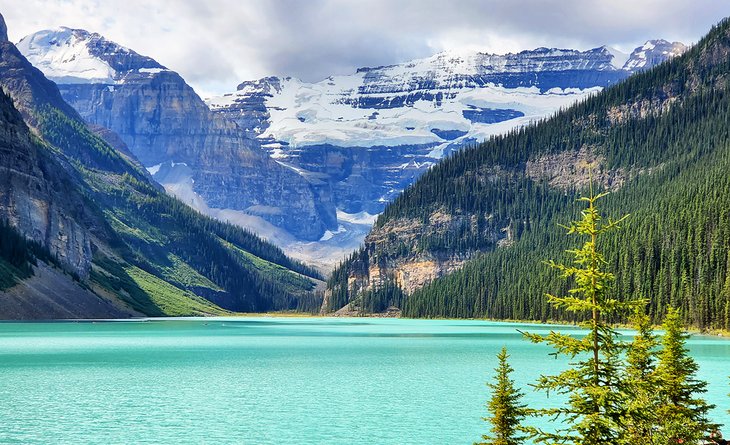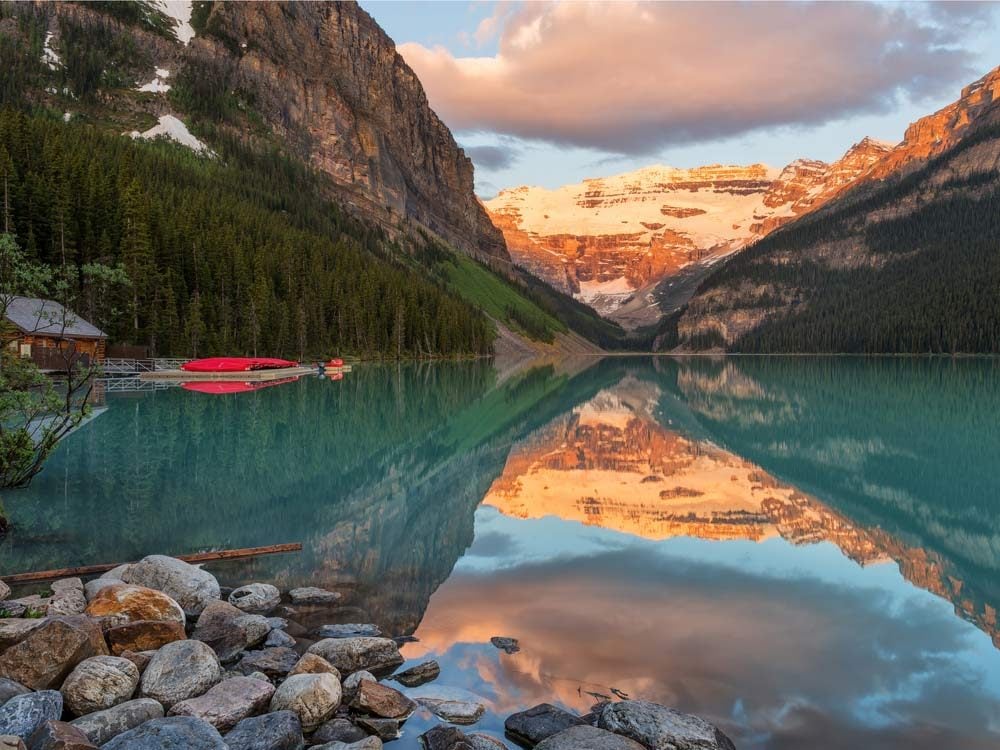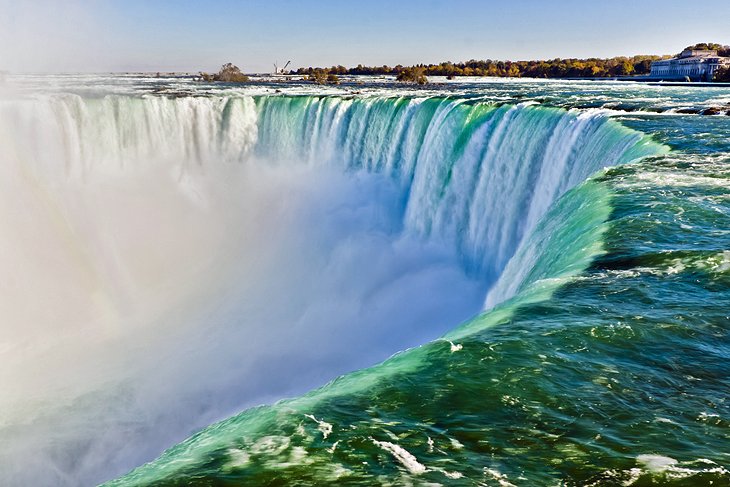
From the thundering cascades of Niagara Falls to the majestic peaks of the Canadian Rockies, and from the vibrant, multicultural streets of Toronto to the charming, cobblestone alleys of Old Quebec, Canada is a land of breathtaking beauty and diverse experiences. As the second-largest country in the world by land area, its sheer scale means there’s an endless array of landscapes, cultures, and adventures awaiting every traveler. This article delves into Canada’s top attractions, offers a glimpse into its rich history, and provides essential travel tips to help you plan an unforgettable journey.
Canada’s Top Attractions: A Journey Through Diverse Landscapes and Cultures
Canada’s appeal lies in its incredible diversity, offering everything from pristine wilderness and adrenaline-pumping outdoor activities to world-class cities and rich cultural experiences. Here are some of its most celebrated destinations:

Related Articles about Canada: A Tapestry of Wonders – Exploring its Top Attractions, History, and Travel Essentials:
- Türkiye: Where History Whispers and Luxury Awaits – A Guide to its Best Hotels and Unforgettable Experiences
- Romania: A Tapestry of Legends, Landscapes, and Unforgettable Experiences
- Nepal: A Journey to the Roof of the World and Beyond
- The Unyielding Pulse of the Metropolis: Your Ultimate Guide to New York City
- Unveiling Nepal: A Journey Through History, Culture, and the Best Hotels in the Land of the Himalayas
The Canadian Rockies: Nature’s Grand Masterpiece
Undoubtedly one of Canada’s most iconic regions, the Canadian Rockies stretch across British Columbia and Alberta, boasting an unparalleled landscape of jagged peaks, turquoise lakes, ancient glaciers, and abundant wildlife.
- Banff National Park: Canada’s first national park and a UNESCO World Heritage site, Banff is a jewel of the Rockies. Its crown jewel, Lake Louise, is world-renowned for its stunning emerald waters set against the backdrop of the Victoria Glacier. Nearby, Moraine Lake offers equally breathtaking views. Visitors can hike, canoe, ski, or simply soak in the majestic scenery. The town of Banff itself is a charming hub with excellent dining, shopping, and accommodation.
- Jasper National Park: The largest national park in the Canadian Rockies, Jasper offers a wilder, more rugged experience. Highlights include the stunning Maligne Lake and its Spirit Island, the powerful Athabasca Falls, and the Columbia Icefield, where you can ride an Ice Explorer onto the Athabasca Glacier. Jasper is also a designated Dark Sky Preserve, making it an ideal spot for stargazing.
- Icefields Parkway: Connecting Banff and Jasper, this scenic highway is consistently ranked among the most beautiful drives in the world. Stretching 232 kilometers (144 miles), it offers continuous panoramic views of ancient glaciers, cascading waterfalls, vast valleys, and emerald lakes. Numerous viewpoints, hiking trails, and picnic spots dot the route, inviting travelers to stop and immerse themselves in the grandeur.
West Coast Wonders: Vancouver and Whistler
British Columbia’s Pacific coast offers a blend of vibrant city life and dramatic natural beauty.

- Vancouver: Consistently ranked among the world’s most livable cities, Vancouver is a modern metropolis nestled between the Pacific Ocean and the North Shore Mountains. Stanley Park, a 1,000-acre urban oasis, offers lush forests, beautiful beaches, and the famous Seawall, perfect for walking, cycling, or rollerblading. Granville Island Market is a foodie’s paradise, while Gastown boasts Victorian architecture and trendy boutiques. Vancouver’s diverse culinary scene, vibrant arts, and proximity to nature make it a captivating destination.
- Whistler Blackcomb: Just a scenic two-hour drive north of Vancouver, Whistler is North America’s largest ski resort and a co-host of the 2010 Winter Olympics. While primarily famous for its world-class skiing and snowboarding, Whistler is a year-round destination. In summer, it transforms into a mountain biking mecca, offering hiking, ziplining, and gondola rides with stunning alpine views. The pedestrian-friendly village is packed with shops, restaurants, and lively après-ski culture.
Central Canada’s Urban and Natural Icons: Toronto, Niagara Falls, and Ottawa
The provinces of Ontario and Quebec form the historical and cultural heartland of Canada, home to major cities and one of the world’s most famous natural wonders.
- Toronto: As Canada’s largest city and a global hub for finance, arts, and culture, Toronto is a microcosm of the country’s multicultural fabric. The iconic CN Tower offers unparalleled views of the city skyline and Lake Ontario, while the Distillery District provides a charming historical escape with its Victorian-era industrial architecture, art galleries, and boutiques. Kensington Market buzzes with bohemian spirit, vintage shops, and diverse eateries, and a ferry ride to the Toronto Islands offers a peaceful retreat and spectacular city views.
- Niagara Falls: Straddling the border between Canada and the United States, Niagara Falls is one of the world’s most powerful and awe-inspiring natural wonders. The Canadian Horseshoe Falls are particularly impressive, with millions of gallons of water thundering over the precipice every minute. Attractions like the Journey Behind the Falls, Maid of the Mist (or Hornblower Niagara Cruises on the Canadian side), and Niagara Parkway offer different perspectives of this magnificent spectacle. The surrounding Niagara-on-the-Lake region is also famous for its picturesque wineries and charming historic town.
- Ottawa: Canada’s capital city, Ottawa, blends national monuments with a relaxed, European feel. Parliament Hill, with its impressive Gothic Revival architecture, is the political heart of the nation and offers free daily tours and the ceremonial Changing of the Guard in summer. The Rideau Canal, a UNESCO World Heritage site, is a popular spot for skating in winter and boating/paddling in summer. World-class museums like the Canadian Museum of History and the National Gallery of Canada provide deep dives into Canadian culture and art.
Quebec’s European Charm: Montreal and Quebec City
The French-speaking province of Quebec offers a distinctly European flavor, with a rich history and vibrant culture.
- Montreal: A dynamic city known for its vibrant arts scene, excellent cuisine, and unique blend of North American and European influences. Old Montreal is a must-visit, with its cobblestone streets, historic buildings like the stunning Notre-Dame Basilica, and charming waterfront. The Plateau Mont-Royal district is famous for its colorful row houses, independent boutiques, and lively cafes. Montreal hosts numerous festivals throughout the year, from jazz to comedy, making it a cultural hotspot.
- Quebec City: The only walled city in North America north of Mexico, Old Quebec is a UNESCO World Heritage site and feels like stepping into a European fairy tale. Dominated by the iconic Fairmont Le Château Frontenac, its narrow streets are perfect for wandering, discovering artisan shops, and enjoying French-inspired cuisine. The Plains of Abraham offer historic significance and beautiful green space, while the Citadelle of Quebec provides a glimpse into military history.
The Atlantic Provinces: Coastal Beauty and Maritime Heritage
Canada’s East Coast, known as the Maritimes, offers rugged coastlines, charming fishing villages, and a distinct cultural identity.
- Peggy’s Cove, Nova Scotia: This picturesque fishing village is famous for its iconic lighthouse perched on a granite outcrop, surrounded by crashing waves. It’s a quintessential East Coast scene, offering stunning photography opportunities and a taste of traditional maritime life.
- Bay of Fundy, Nova Scotia/New Brunswick: Home to the highest tides in the world, the Bay of Fundy is a natural wonder. At places like Hopewell Rocks in New Brunswick, you can walk on the ocean floor at low tide and kayak among the flowerpot formations at high tide. Whale watching tours are also popular here.
- Cabot Trail, Cape Breton Island, Nova Scotia: Consistently ranked among the world’s most scenic drives, the Cabot Trail winds around the northern tip of Cape Breton Island, offering breathtaking coastal and highland views. It passes through Cape Breton Highlands National Park, where hiking trails lead to spectacular vistas and opportunities to spot moose and eagles.
A Glimpse into Canada’s Rich History
Canada’s history is a complex and fascinating narrative shaped by Indigenous peoples, European colonization, and a journey towards a multicultural, independent nation.
For millennia before European arrival, Indigenous peoples – including First Nations, Inuit, and Métis – thrived across the land, developing diverse cultures, languages, and sophisticated societies. Their deep connection to the land and intricate knowledge of its ecosystems formed the bedrock of early Canadian history.
European contact began in the late 15th and early 16th centuries with Viking expeditions, followed by the permanent arrival of French and British explorers. Jacques Cartier claimed the land for France in 1534, leading to the establishment of New France and settlements like Quebec City (1608) and Montreal (1642). The fur trade became a crucial economic driver, fostering both cooperation and conflict with Indigenous communities.
The 18th century saw intense rivalry between Britain and France, culminating in the Seven Years’ War (French and Indian War in North America). The Battle of the Plains of Abraham in 1759 led to British control of New France, formalized by the Treaty of Paris in 1763. This period brought a significant influx of British settlers and Loyalists fleeing the American Revolution, leading to the division of the colony into Upper and Lower Canada (now Ontario and Quebec).
The desire for greater autonomy and the need for a stronger union against potential American aggression led to Confederation in 1867. Four provinces – Ontario, Quebec, Nova Scotia, and New Brunswick – united to form the Dominion of Canada. Over the following decades, more provinces and territories joined, gradually shaping the Canada we know today.
The 20th century saw Canada play significant roles in both World Wars, assert its independence from Britain, and embrace a policy of multiculturalism. Immigration from around the globe transformed the country into a vibrant mosaic of cultures, languages, and traditions, making diversity a defining characteristic of modern Canada. Understanding this history provides a richer context for appreciating the country’s diverse attractions, from its historic sites to its vibrant cultural landscapes.
Navigating the Great White North: Essential Travel Tips
Traveling in Canada, especially given its vastness, requires some planning. Here are practical tips to ensure a smooth and enjoyable trip:
- Visa and Entry Requirements: Most visitors will need an Electronic Travel Authorization (eTA) if flying into Canada, or a visitor visa, depending on their nationality. Check the official Government of Canada website well in advance. US citizens only require a valid passport.
- Currency: The Canadian Dollar (CAD) is the official currency. Credit cards are widely accepted, but it’s wise to carry some cash for smaller purchases or remote areas.
- Language: Canada has two official languages: English and French. English is spoken throughout the country, while French is predominant in Quebec and widely spoken in parts of New Brunswick and Eastern Ontario. Learning a few basic French phrases (Bonjour, Merci, S’il vous plaît) will be appreciated in Quebec.
- Tipping: Tipping is customary in Canada for services like restaurants (15-20%), taxis (10-15%), and hospitality staff.
- Weather and Packing: Canada experiences four distinct seasons, and weather can vary significantly by region. Pack layers, even in summer, and be prepared for sudden changes. If traveling in winter, bring warm clothing, including hats, gloves, and waterproof outerwear.
- Distances: Canada is enormous. Do not underestimate travel times, especially if planning a road trip across multiple provinces. Flying is often necessary for long distances.
- Travel Insurance: Highly recommended. Healthcare can be expensive for non-residents.
- Wildlife Awareness: When exploring national parks or wilderness areas, be aware of local wildlife (bears, moose, coyotes). Follow park guidelines, carry bear spray if recommended, and never feed animals.
Where to Stay: Accommodation Options
Canada offers a wide range of accommodation to suit every budget and travel style:
- Hotels: From luxurious five-star establishments in major cities (e.g., Fairmont, Marriott) to budget-friendly chains (e.g., Holiday Inn Express, Best Western), hotels are plentiful. Boutique hotels offer unique character in urban centers.
- Bed & Breakfasts (B&Bs): Especially popular in smaller towns and scenic regions, B&Bs offer personalized service, charming atmospheres, and often a delicious homemade breakfast.
- Vacation Rentals: Platforms like Airbnb and VRBO are popular, offering apartments, cabins, and houses, which can be ideal for families or longer stays.
- Hostels: A budget-friendly option, particularly in major cities and popular tourist areas, offering dorm rooms and private rooms.
- Camping and Glamping: National and provincial parks offer excellent camping facilities. For a more luxurious outdoor experience, glamping options (yurts, furnished tents) are increasingly available.
- Resorts: Ski resorts like Whistler, and luxury lodges in the Rockies, provide all-inclusive experiences with various amenities and activities.
Getting Around: Transportation in Canada
Navigating Canada’s vast landscapes requires understanding the best transportation options:
- Air Travel: For covering long distances between major cities (e.g., Vancouver to Toronto, Montreal to Calgary), flying is the most practical and time-efficient option. Air Canada and WestJet are the main domestic carriers. Regional airlines serve smaller airports.
- Train: VIA Rail Canada operates passenger rail services across the country, offering a scenic but slower alternative to flying. The "Canadian" route from Toronto to Vancouver is a multi-day journey offering stunning views. The Rocky Mountaineer offers luxury, daylight-only scenic tours through the Canadian Rockies.
- Bus: Inter-city bus services like Greyhound (though much reduced in recent years, especially in Western Canada), FlixBus, and regional operators provide a more budget-friendly option for travel between cities and towns, particularly within provinces.
- Rental Cars: For ultimate flexibility and exploring national parks, rural areas, or specific scenic drives (like the Icefields Parkway or Cabot Trail), renting a car is highly recommended. Book in advance, especially during peak season, and be aware of potential one-way rental fees.
- Public Transportation: Major cities like Toronto, Montreal, and Vancouver have efficient public transit systems (subways, buses, streetcars) for getting around within the urban core.
- Ferries: BC Ferries connects Vancouver Island and other coastal communities to the mainland. Ferries are also essential for reaching islands in the Maritimes (e.g., Prince Edward Island, Newfoundland).
When to Go: Best Time to Visit
The "best" time to visit Canada largely depends on your desired activities and the region you plan to explore.
- Summer (June to August): This is peak tourist season across most of Canada. The weather is generally warm and sunny, ideal for hiking, camping, exploring cities, and enjoying outdoor festivals. The Rockies are fully accessible, and the East Coast’s coastal beauty shines. However, expect larger crowds and higher prices for flights and accommodation.
- Fall (September to October): A favorite for many, fall offers crisp air, fewer crowds, and spectacular foliage displays, especially in Eastern Canada (Ontario, Quebec, Maritimes). It’s also an excellent time for hiking in the Rockies, though some higher elevation trails may see early snow. Temperatures are cooler but generally pleasant.
- Winter (November to March): For winter sports enthusiasts, this is the time to visit. World-class ski resorts like Whistler, Banff, and Mont-Tremblant come alive. Major cities host festive markets and winter carnivals (e.g., Quebec Winter Carnival). Expect cold temperatures and significant snowfall, but also stunning snow-covered landscapes and unique cultural experiences.
- Spring (April to May): A transitional season, spring sees thawing landscapes and blooming flowers. It’s generally quieter with fewer tourists and potentially lower prices. It’s a good time for city breaks, and wildlife viewing opportunities increase as animals emerge from hibernation. However, some mountain trails may still be snowy, and weather can be unpredictable.
Conclusion
Canada is a country that truly offers something for everyone, a vast and welcoming land where natural grandeur meets urban sophistication, and ancient history blends seamlessly with vibrant multiculturalism. Whether you’re drawn to the serene majesty of a glacial lake, the pulsating energy of a metropolis, the historic charm of a European-style city, or the rugged beauty of a maritime coast, Canada promises an unforgettable journey. With careful planning, an adventurous spirit, and these travel essentials in hand, you are ready to embark on an incredible exploration of the Great White North.





